 Leading Blog | Posts by Month |
 Leading Blog | Posts by Month |
09.30.18

LeadershipNow 140: September 2018 Compilation
See more on
Posted by Michael McKinney at 08:25 AM
09.25.18

What Happens Now? A Look at 7 Reasons Leaders Stall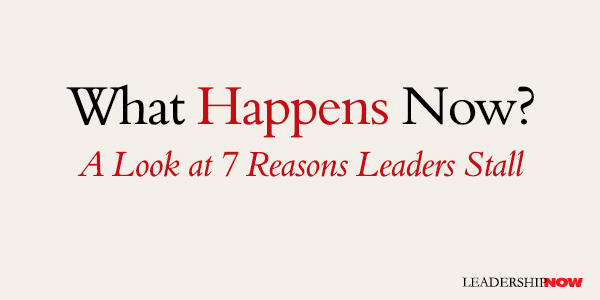
T As you take on more responsibility, the demands on you as a leader change. If disrupting yourself isn’t part of who you are, you will get left behind. If you are just doubling down on what you’ve always done, you will miss the opportunities. When conditions change, you have to change too. That’s why John Hillen and Mark Nevins wrote What Happens Now? to help you remain a leader. “If we are to generalize, we can say that you advance as a leader, the technical and tactical skill you need—distribution expertise, for example—pale in comparison to the strategic and interpersonal.” Complexity Skills and Sophistication Skills They divide leadership capabilities into two groups: complexity skills and sophistication skills. Complexity skills are often what got you in the door. Complexity skills are those abilities that help you to deal with complexity “in a traditional-management-centered way, such as knowing how to design and implement processes and systems, and having the required technical and functional knowledge.” Sophistication skills are behavior and mindset related. They are about changing how you do what you do. “How you pull back and understand the bigger realities of the job. How you approach doing the job having done so. How you think and behave so your people eagerly receive your leadership. Getting the how right is the challenge when it comes to sophistication.” Too often, we don’t look at ourselves when we run into problems. We look around and ask what’s wrong with them. Warren Bennis and James O’Toole wrote, “Most of us wear the concrete shoes of our earlier successes.” We tend to focus on and fall back on Complexity skills rather than grow and develop our Sophistication skills. Complex challenges are easier to wrap your mind around. You can measure them. Sophistication challenges are not as clear. They can be more painful as they get into more personal aspects of who you are as a person. But distinguishing between the two challenges is critical. Our leadership stalls when we try to use tools for solving complexity issues when we “need to develop the capabilities to lead in a more sophisticated way.” Complexity challenges, which often come with growth in scale, can make your job bigger in ways you can’t anticipate. Sophistication challenges, which usually come with change in kind, make the job broader in ways you don’t anticipate. If you’re like most leaders, you’ll display more comfort with complexity and decidedly less comfort with sophistication. 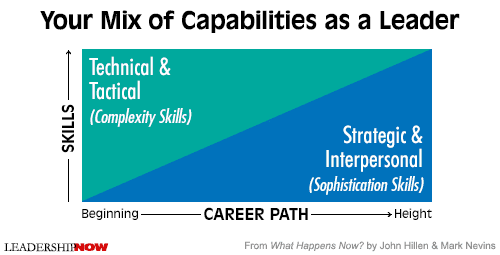 As you rise as a leader, sophistication skills take on greater importance. What are the new capabilities on which your leadership success will depend? More importantly, which skills that you value today should you deemphasize—or resist exercising at all? No matter how good your complexity skills are if you fail to access your sophistication skills by regularly challenging yourself as to what and how you do what you do, you risk stalling as a leader. The authors identify seven inflection points that can trigger a stall in your leadership. Purpose Stall
Teamwork Stall
Stakeholder Stall
Leading Change Stall
Authority Stall
Focus Stall
Leadership Development Stall
What Happens Now? is a great look at some of the most critical issues in leadership. The authors walk you through each of these stalls to help you overcome or avoid them. Of course, self-awareness is key here—understanding the impact you have on others. Elevate your view and understand where you are and determine where you need to be. They call for a three-part approach: become more aware of what’s changing in your environment, know where you are, and then act deliberately to develop capabilities that will change your behaviors and thinking. Every stall is an opportunity for growth. When you deal with each stall head-on, “you position yourself to evade the pain and consequences of being caught in future stalls. When you ask yourself, ‘What happens now?’ you’ll be ready to answer: ‘I will look inside, see myself as others see me and as they want and need me to be, and act to remake myself.’ You won’t blame your troubles on your organization or people, or ask, ‘How do I change the institution to overcome these challenges?’ You’ll see yourself as part of the slowdown. And then you’ll be ready to become you own ‘Best Leader Ever.’” This is not a process of abandoning the complexity skills that got you where you are, but instead adding to and developing “your leadership repertoire with a new set of executive capabilities, mindsets, and behaviors” to help you to overcome the new challenges of sophistication that will come your way. 
Posted by Michael McKinney at 10:00 AM
09.20.18

Three Strategies to Encourage Good Mental Health in the Workplace
L Unfortunately, for many people, fluctuating feelings can run on overdrive in response to a society overflowing with negativity – think natural disasters, mass shootings, suicides, and even a heated political environment all occurring with disturbing regularity. There are also stressful personal events in our lives that add to the swinging emotional pendulum, like the death of a loved one, the end of a relationship or the loss of a job. According to a recent study, employees suffering from depression cost employers more than $44 billion per year in lost productivity, with over 81 percent of that decreased productivity coming in the form of presenteeism or the practice of going to work despite illness or anxiety and commonly resulting in reduced productivity. While it’s not uncommon to feel like you are carrying the weight of the world on your shoulders, I believe by recognizing and taking ownership of our sometimes-wavering emotions – especially in the workplace – we can change our course for the better. By working to shift the residual emotional effects of stressful situations and embracing more positivity, we can strive to achieve enhanced well-being and professional success. For this strategy to be effective, leaders must start by taking a top-down approach to dealing with mental health in the workplace. By creating and implementing effective mental health programs within their organization, companies can experience greater staff member well-being, boost productivity and contribute to transforming our country’s corporate culture regarding mental health. Mental Health Defined Before getting to my tips on how management can get started with this mission, it’s important to review the various definitions of mental health. At its core, mental health is “the emotional resilience which allows us to enjoy life, create friendships and be productive at our jobs.” This emotional flexibility helps us cope with life’s disappointments and setbacks, such as death, familial conflict or other stressful situations. Protecting our mental health is as essential as protecting our physical well-being. Stress, anxiety and depression are the most common forms of clinically diagnosed mental health disorders. Fortunately, many of these disorders can be treated with social supports (however, in some cases, some individuals require medical intervention). On a personal level, it’s no secret that mental ill-health can lead to general unhappiness. As a result, it can impact our lives in the professional world, costing businesses millions of dollars due to absenteeism, high staff turnover, and presenteeism. As such, today’s business leaders and employers must make it a priority to serve as instruments of change in our current negatively charged, turbulent environment. So, how can you get started to ensuring that your employees have good mental health in the workplace? The Domino Effect of Positivity As an international speaker, mental health expert, and author, I have been fortunate to travel around the globe throughout my career meeting with hundreds of business owners and entrepreneurs about mental wellness. The consensus among these individuals is that when you focus on taking care of your own emotional health, the resulting positivity has a contagious effect, especially when it comes to relationships between leaders and employees. Executives at the top of the chain of command must start by looking for any signs of higher than average employee stress, including regular complaining, and anger or reduced (or a boost in) productivity. While altering attitudes to mental health in the workplace should be a priority, it can be daunting for some leaders to fully understand how they can support a staff member’s well-being. Here are three strategies to improve how you approach mental health within your organization:
The Bottom Line When leaders make conscious efforts to embrace positivity – even in turbulent times – we can help our employees experience increased positivity and more success. The statistics about making such efforts are telling: one recent study by ValueOptions revealed that employees who utilized mental health tools (and met with a mental health provider) reported a decrease in absenteeism, and considerable improvement in both productivity and overall mental health. As we become increasingly savvier to our society’s mental health needs, it’s in every manager’s best interest to implement a focus on positivity in the workplace. The long-term investment in mental health awareness, education and training will inevitably create returns that outweigh the loss of productivity in the professional world.  Kellerer is the co-author of The Soul of Success with Jack Canfield and the author of the recently-released title, One Moment Can Change Your Life: Extraordinary Stories about Ordinary People. Today, he dedicates his time to fighting the depression epidemic and promoting mental wellness in the workplace. You can connect with him on LinkedIn, Twitter and Facebook.
Posted by Michael McKinney at 08:59 AM
09.17.18

What Can’t Be Copied?
I Kevin Kelly highlights a number of things that can’t be manufactured in his book, The Inevitable. They are things that add value to what is a commodity. He begins with trust. Trust
Immediacy
Personalization
Interpretation
Authenticity
Accessibility
Embodiment
Patronage
Discoverability
While everything on this list adds value, one item stands out from the rest. And that is trust. The other items on the list should be evaluated as to how they might add differentiation to your offering, but leaders need to focus on championing trust and other character issues as a first line of defense to commoditization. These of course, are the hardest to develop and establish but they are the only differentiators that will stand the test of time—the only ones that can never be copied. Times change but character never does. Good character is hard to measure but it is easily identified. It has universal value, transcending cultures, gender, and races. Character engenders passion and commitment. It gives weight to everything you do. In short, it endures. 
Posted by Michael McKinney at 08:06 AM
09.13.18

That’s Not How We Do It Here!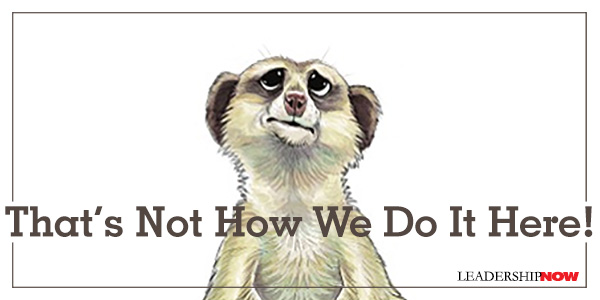
B It is the story of Nadia bright and adventurous meerkat who is part of a mature clan with over 150 members. This well-managed clan has done well to date but is now faced with unprecedented problems that challenge their once reliable rules and procedures. Unable to be heard in her clan, Nadia ventures out to see how other clans are dealing with the changes. She finds partial answers in the approach a smaller, loosely organized clan. Returning to her own clan, she figures out how to combine the best of both worlds—a large, disciplined, well-managed clan and that of a small, informal, inspiring clan. The story parallels the evolution of organizations of all types as they grow and mature. As illustrated in the chart below, most organizations begin by taking the approach in upper left corner (almost by definition). While a bit chaotic, they are curious, adaptable, and energetic. They are learning. But once success comes they nearly always move into the upper right quadrant. They begin to cope with their size by cementing in systems, structures and policies, that inadvertently kill speed, agility and innovation. New ideas are often greeted with, “That’s not how we do things around here.” If they persist in this approach, they quickly fall into the lower right corner, becoming complacent, rigid, and slow. The very talent they need to stay relevant and responsive to their changing environment begins to leave. If dramatic change comes their way, they are doomed. 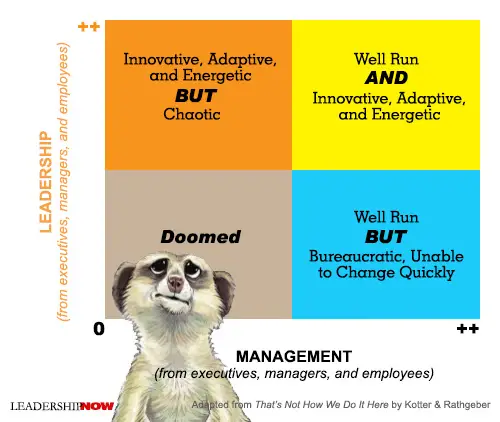 The answer isn’t to move back to the upper left corner. The answer is to combine the two by changing the way the organization is led. The authors suggest that leader begin by creating a sense of urgency around a clear opportunity and mission. Add to that a network-like system that spans silos and layers of hierarchy. These become entrepreneurial units that rekindle a sense of curiosity and learning. Contrary to the nature of a mature organization, much of this is dependent on the leadership’s willingness to communicate and embrace and nurture new ideas. Faced with the environment we are all in, we can no longer comfortably lead the well-managed, calcified organization to its doom. 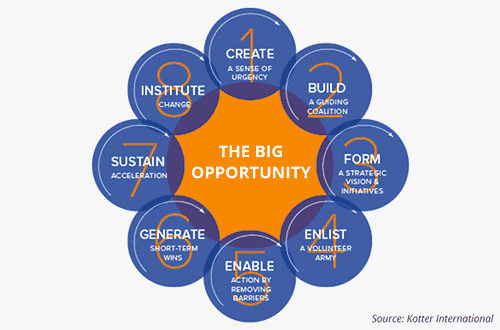 
w on Instagram" target="_blank">Instagram and Facebook for additional leadership and personal development ideas. 
Posted by Michael McKinney at 08:24 AM
09.11.18

Smart Business is Business Redefined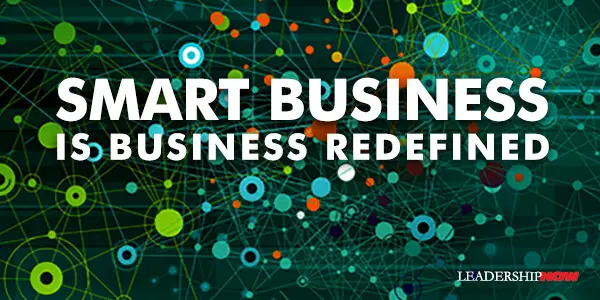
I In 2016, Alibaba facilitated sales of $15 billion. In 2016, Black Friday and Cyber Monday saw less than 3.5 billion dollars. In 2017, three minutes after the day opened at midnight, $1.5 billion in sales had been transacted. At the peak, Alibaba’s technology platforms processed 325,000 orders and 256,000 payments every second. It’s amazing when you think that VISA’s stated capacity as of August 2017 was 65,000 payments per second globally. Logistics? “Just twelve minutes after the midnight start, the first package arrived at a customer’s door in Shanghai. Three minutes later, a woman in Ningbo on China’s Pacific coast received the first imported package. Before 9:30 a.m., a hundred million packages had already shipped.” Singles Day is a technological marvel. But it would be wrong to think of Alibaba as China’s Amazon. To think of it this way “obscures Alibaba’s breakthrough business model and the window it provides on how the economic scene is evolving.” The technology and business model Ming Zeng, the chairman of the Academic Council of the Alibaba Group, describes in Smart Business: What Alibaba’s Success Reveals About the Future of Strategy. Unlike Amazon, Alibaba is not even a retailer in the traditional sense—we don’t source or keep stock, and logistics services are carried out by third-party service providers. Instead, Alibaba is what you get if you take every function associated with retail and coordinate them online into a sprawling, data-driven network of sellers, marketers, service providers, logistics companies, and manufacturers. Zeng summarizes the formula for smart business with this simple equation: “That simple equation reveals what is behind Alibaba’s success and captures everything you need to know about business in the future. Success is strength in both networks and data.” In its broadest sense, network coordination is the breaking down of complicated business activity so that groups of people or firms can get it done more effectively. Smart business then, is when all participants involved in achieving a common goal are coordinated in an online network and use machine-learning technology to efficiently leverage data in real-time to generate relevant responses. A case in point: 25-year-old Zhang Linchao is the head of China’s online clothing brand, LIN Edition. Turning her clothing hobby into a business, she turned to Taobao, Alibaba’s Chinese e-commerce platform. In 2015, she prepared to sell a batch of 15 new clothing items at 3:00 p.m. Ten of thousands so of fans are waiting for the sale to begin having already seen previews of this sale on social media. She expects to sell several thousand items but has only had 1000 pieces in stock—total. At 3:00 p.m. 60,000 users are visiting the store. Within one minute, everyone one of the fifteen clothing items sells out. Now preorders are sold. By 3:45 p.m., she has sold more than 10,000 items with each customer spending an average of $150 per order. Linchao has created an on-demand business—but at mass production price points. What is remarkable is that she finds her customers on social media, keeps almost no inventory, and owns no factories. Yet the customer has the product in 7 to 10 days. The business model is efficient and responsive. Smart businesses like LIN and many others rely heavily on machine-learning technology to achieve scale and manage complexity. Alibaba uses “technology to coordinate business activity across a nearly unlimited number of interconnected parties.” A business strategy is no longer based on competition, but coordination. Routine decisions are made automatically by machines driven by data. “Organizations are no longer static, hierarchical structures that need managing and controlling, but rather are dynamic, fluid networks of interconnected players that must be engaged by mission and opportunity.” Strategy Is About Learning, Not A Plan Strategy in a smart business is not long-term or short-term planning. It’s not planning at all. It’s more like learning. Strategy is continually updated by continuous real-time experimentation and customer engagement, which “creates feedback, which leads to adjustment of the vision, which in turn guides new experiments.” Can we run a business like an algorithm? What Does this Mean for Organizations? The Creativity Revolution is here. Organizations in the Creativity Age will focus on creativity and innovation. “An organization’s goal is to improve the efficiency of innovation founded on human insight and creativity.” This cannot be managed in the traditional way. A smart business is “no longer a vessel for conveying orders from the top. It is a vacuum sucking up information about its environment and then generating and coordinating effective responses. The job of leadership is not to manage this experiment, but to make it possible and boost its success rate.” Think enabling not managing. Through enabling mechanisms, management provides the necessary conditions to tackle business problems through innovation as opposed to the execution of tried-and-true procedures. This means managers must now focus on things like articulating the mission and providing the environment that attracts the right collaborators, supplying the tools for them to experiment and scale successful ideas, and providing a market to assess the innovation’s success. Instead of micromanaging the firm, management creates the organization’s architecture to run itself. To do this you need a strong culture and the people that fit that culture. “Hiring is the single most important thing a company can do to preserve culture.” Culture “works to segregate as much as it does to bring people together.” To that end, Alibaba has HR workers randomly assigned to interview employee candidates called, “chief olfactory officers. Their job is to sniff out the match between candidates and the strong corporate culture.” From Zeng’s perspective, “the individual has more potential than maybe at any other time in history.” New technologies can free individuals from static organizations. New technologies “need not swallow the individual, but instead can propel you forward toward greater heights.” Smart Business is one of the most fascinating books you’ll read this year on strategy and the future of business. At the very least it will expand your perspective. Zeng details the principles and practices that companies need to become smart businesses and the implications to the organization of those implemented principles and practices. Singles Day is an example of what is possible when networks and data are brought together at the same time. “Thousands of companies come together seamlessly and instantly to provide millions of customers with what they want. Unimaginable scale is possible when businesses are smart.” 
Posted by Michael McKinney at 07:35 AM
09.07.18

Didn't See It Coming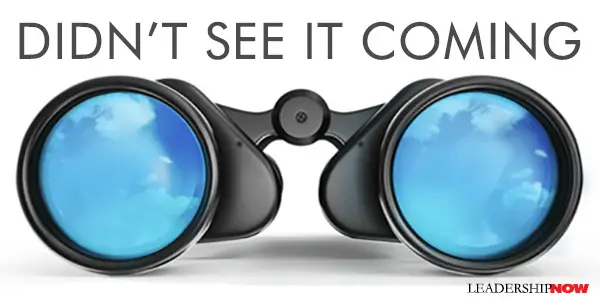
T Carey Nieuwhof is the author of Didn’t See It Coming. He wrote this book because too often we don’t. And even though these seven challenges never really go away, we can create some life habits that keep them at bay. Nieuwhof writes from a been-there-done-that Christian perspective about the issues as they manifest themselves in our lives and follows up each one with a chapter on how to combat it. It’s not really just for leaders. These issues affect everyone and some you'll find hit close to home. The seven challenges are: Cynicism
Compromise
Disconnection
For me, the sense that a conversation is going nowhere always carries with it an underpinning of judgment and even arrogance on my part. I just assume I’m better, smarter, or wiser or that I have greater emotional intelligence than others. Which, of course, should drive me right back to my knees in confession. After all, we’re encouraged to think of others as better than ourselves. That’s a cornerstone habit of the humble. Irrelevance
Pride
Burnout
Emptiness
Didn’t See It Coming is full of understanding and insight. The practical advice found here will benefit anyone on their leadership journey.   
Posted by Michael McKinney at 08:01 AM
09.05.18

The Physics of Innovation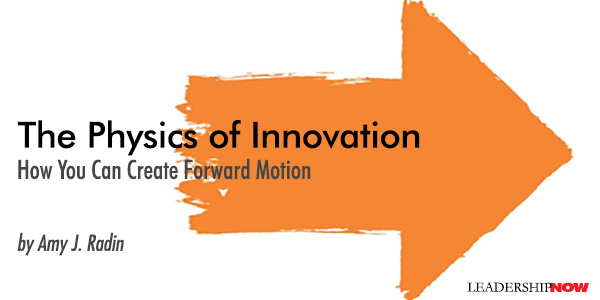
A What we were taught in high school science, F = MA, force = mass times acceleration, also describes the physics of innovation. The laws of innovation may be an entirely different application than Newton intended, but tracking through on the metaphor yields pragmatic tips for innovators. Innovation faces the inertia of the status quo defined by team members, organization culture, and whatever product or service solutions already exist. These all become anchors for evaluating the desirability of anything new. Every member of a team in any organization brings with them some version of “the way things have always been done.” Users have ways they are solving the problems innovations claim to address. Change makers – whether corporate innovators, founders, or investors – improve their odds of moving their ideas from napkin back and prototype to commercial reality at scale when they acknowledge that one of their biggest challenges is overcoming the bias to maintain things as they are. How can change makers create the forward motion to dilute the impact of inertia so they can advance innovation? Here are four imperatives based upon the physics of innovation: Know and convey your purpose. Purpose is not about a slogan on the conference room wall. It’s about knowing what you stand for, why your enterprise exists, and why you are there. With purpose backed by passion and commitment, you can challenge and motivate yourself and others to accomplish hard goals. Purpose creates the fuel – the intensity – required to change the status quo of what is, towards the change maker’s view of what is possible. Chunk down whatever you are trying to create into small steps. By bringing people with different perspectives together to iterate ever-improving prototypes, and exposing the prototypes to users at each step, the change maker accomplishes key objectives: Collaboration and inclusion build buy-in as people feel heard and are able to contribute their expertise. Costly mistakes are avoided as innovations that are true departures from the status quo evoke counter-intuitive responses – good and bad. And, iteration feeds the next item on this list -- speed. Move fast. Taking multiple steps to iterate a prototype before declaring readiness to go to market may feel like a slowdown. But in fact, chunking down the work into iterative cycles can compress the time it takes to get to market with a product or service that works, and that people really want to own and use. Imagine the difference between a fully unfurled piece of string, and one of the same length compressed into a coil. The two strings represent the difference between the start and end times for a linear approach versus one that is iterative. Follow the ‘compliment then complement’ principle. Some amount of resistance to innovation happens when people tied to a prior success see the next big thing as a repudiation of their past contributions. Take the edge off this emotional impulse by signaling respect and empathy with a simple practice: Compliment with an ‘i’ then complement with an ‘e’. Here’s an example of how this sounds, in the case of introducing client segmentation to insurance agents accustomed to mining their contact lists one-at-a-time for leads: “You have done an amazing job within your network identifying new clients. We can offer you a new tool to try out that might allow you to achieve even better results by tagging your contacts with a segment identifier. Others are finding this is helping them to win new business.”  Follow Amy on Twitter and LinkedIn. You can download an excerpt of The Change Maker’s Playbook on her website.
Posted by Michael McKinney at 09:07 AM
09.03.18

Business Chemistry: What Type Are You?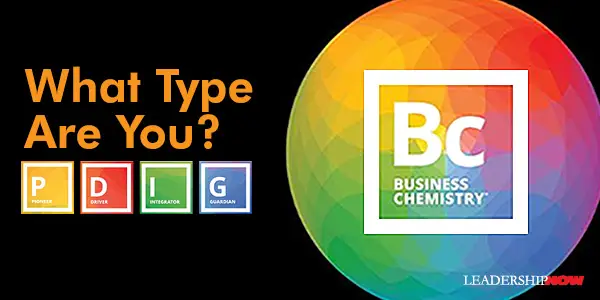
T Business Chemistry is a tool for self-understanding and empathy—a way to identify meaningful differences between people’s working styles and perspectives. Kim Christfort and Suzanne Vickberg of Deloitte helped to develop Business Chemistry. It does not invalidate everything else of its type, rather it is designed to be simpler and thereby memorable and actionable on issues that really matter for people in the work environment. And it is quite straightforward for both accessing yourself and others you work with. Using the key sticking points between people, they identify 4 Working Styles:
The authors naturally go into detail on each of these types and give an example of a well-known person that fits that type. They also delve into difference between the types as they relate to stress (Pioneers are the least stressed.), career aspirations, environments they thrive in, and where each type if found organizationally and generationally. The trick of course, is to use this knowledge to modify you own behavior. Otherwise it’s just a game. “By learning about your own type and developing a hunch about the types of those you work with, you can see right away where some of your key differences and similarities are. Then you can determine how you might flex your own style to better match the preferences of those around you.” For example, too many constraints can completely shut a Pioneer down, while a Guardian may withdraw in an environment that feels too chaotic. A Driver may become very frustrated in an organization that lacks decisiveness, while an Integrator may wither on a team that doesn’t value broad-based input. Knowing these trigger points can help you as a leader to give people more of what they need to excel and less of what will turn them off. To understand your own style and develop your hunch about others you know, they’ve developed a test which you can take here. If you’re going to try it out for yourself, you might think about what you are naturally inclined to do and what you have learned to do. I might want to be direct with others but I have learned that I am more productive when I am diplomatic. But being that that is my natural tendency, I probably prefer when people are direct and concise with me. That fact would affect my working style profile. Interestingly, 32% of Millennials are most likely Guardians. They prefer having all of the answers and enjoy zooming into every detail. 29% of Baby Boomers are most likely to be Pioneers or Integrators. They grew up in a different time and may have adopted a more novelty-seeking and relationship–focused orientation. 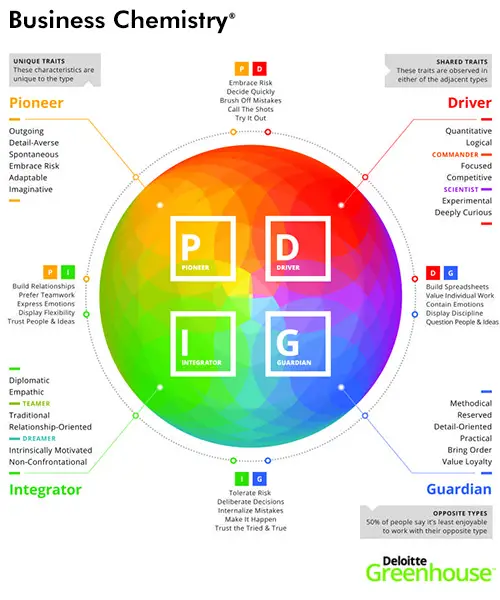 
Posted by Michael McKinney at 08:21 AM
09.01.18

First Look: Leadership Books for September 2018Here's a look at some of the best leadership books to be released in September 2018. Don't miss out on other great new and future releases.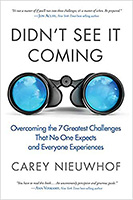 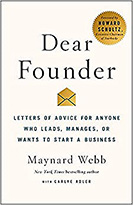 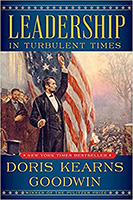  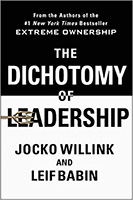
For bulk orders call 1-626-441-2024  Build your leadership library with these specials on over 39 titles. All titles are at least 40% off the list price and are available only in limited quantities. "Read deep! Read often! Out-READ the Competition!!!" — Tom Peters
Posted by Michael McKinney at 07:11 AM
|
BUILD YOUR KNOWLEDGE


How to Do Your Start-Up Right STRAIGHT TALK FOR START-UPS 
Grow Your Leadership Skills NEW AND UPCOMING LEADERSHIP BOOKS 
Leadership Minute BITE-SIZE CONCEPTS YOU CAN CHEW ON 
Classic Leadership Books BOOKS TO READ BEFORE YOU LEAD |
|